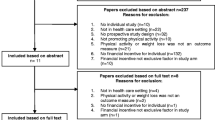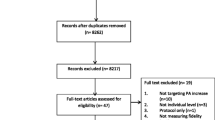Abstract
Background
The effectiveness of reinforcing exercise behavior with material incentives is unclear.
Purpose
This study aims to conduct a systematic review of existing research on material incentives for exercise, organized by incentive strategy.
Methods
Ten studies conducted between January 1965 and June 2013 assessed the impact of incentivizing exercise compared to a non-incentivized control.
Results
There was significant heterogeneity between studies regarding reinforcement procedures and outcomes. Incentives tended to improve behavior during the intervention while findings were mixed regarding sustained behavior after incentives were removed.
Conclusions
The most effective incentive procedure is unclear given the limitations of existing research. The effectiveness of various incentive procedures in promoting initial behavior change and habit formation, as well as the use of sustainable incentive procedures should be explored in future research.

Similar content being viewed by others
References
Troiano RP, Berrigan D, Dodd KW, et al. Physical activity in the United States measured by accelerometer. Med Sci Sports Exerc. 2008; 40: 181-188.
Pate RR, Freedson PS, Sallis JF, et al. Compliance with physical activity guidelines: Prevalence in a population of children and youth. Ann Epidemiol. 2002; 12: 303-308.
Martinez-Gonzalez MA, Varo JJ, Santos JL, et al. Prevalence of physical activity during leisure time in the European Union. Med Sci Sports Exerc. 2001; 33: 1142-1146.
Kohl HW III, Craig CL, Lambert EV, et al. The pandemic of physical inactivity: Global action for public health. Lancet. 2012; 380: 294-305.
Lee IM, Shiroma EJ, Lobelo F, et al. Effect of physical inactivity on major non-communicable diseases worldwide: An analysis of burden of disease and life expectancy. Lancet. 2012; 380: 219-229.
Pratt M, Norris J, Lobelo F, Roux L, Wang G: The cost of physical inactivity: Moving into the 21st century. Br J Sports Med. 2012. doi:10.1136/bjsports-2012-091810.
Oldridge NB. Economic burden of physical inactivity: Healthcare costs associated with cardiovascular disease. Eur J Cardiovasc Prev Rehabil. 2008; 15: 130-139.
Skinner BF. Science and human behavior. Cambridge: B.F. Skinner Foundation; 1953.
King D, Greaves F, Vlaev I, Darzi A. Approaches based on behavioral economics could help nudge patients and providers toward lower health spending growth. Health Aff (Millwood). 2013; 32: 661-668.
Thaler RH, Sunstein CR. Nudge: improving decisions about health, wealth, and happiness. Revised and expanded edition. New York: Penguin; 2009.
Ikeda S, Kang MI, Ohtake F. Hyperbolic discounting, the sign effect, and the body mass index. J Health Econ. 2010; 29: 268-284.
Ainslie G. Breakdown of will. New York: Cambridge; 2001.
Gilbert DT, Wilson TD. Prospection: Experiencing the future. Science. 2007; 317: 1351-1354.
Kahneman D, Snell J. Predicting utility. In: Hogarth R, ed. Insights in decision making. Chicago: University of Chicago; 1990.
Mellers BA, McGraw AP. Anticipated emotions as guides to choice. Current Directions in Psychological Science. 2001; 10: 210-214.
Loomes G, Sugden R. Regret theory: An alternative theory of rationale choice under uncertainty. Economic Journal. 1982; 92: 805-824.
Tversky A, Kahneman D. The framing of decisions and the psychology of choice. Science. 1981; 211: 453-458.
Wall J, Mhurchu CN, Blakely T, Rodgers A, Wilton J. Effectiveness of monetary incentives in modifying dietary behavior: A review of randomized, controlled trials. Nutr Rev. 2006; 64: 518-531.
Burns RJ, Donovan AS, Ackermann RT, et al. A theoretically grounded systematic review of material incentives for weight loss: Implications for interventions. Ann Behav Med. 2012; 44: 375-388.
Kollins SH, McClernon FJ, Van Voorhees EE. Monetary incentives promote smoking abstinence in adults with attention deficit hyperactivity disorder (ADHD). Exp Clin Psychopharmacol. 2010; 18: 221-228.
Stoops WW, Dallery J, Fields NM, et al. An internet-based abstinence reinforcement smoking cessation intervention in rural smokers. Drug Alcohol Depend. 2009; 105: 56-62.
Tevyaw TO, Colby SM, Tidey JW, et al. Contingency management and motivational enhancement: A randomized clinical trial for college student smokers. Nicotine Tob Res. 2009; 11: 739-749.
Volpp KG, Troxel AB, Pauly MV, et al. A randomized, controlled trial of financial incentives for smoking cessation. N Engl J Med. 2009; 360: 699-709.
Giuffrida A, Torgerson DJ. Should we pay the patient? Review of financial incentives to enhance patient compliance. BMJ. 1997; 315: 703-707.
Galarraga O, Genberg BL, Martin RA, Barton Laws M, Wilson IB. Conditional economic incentives to improve HIV treatment adherence: Literature review and theoretical considerations. AIDS Behav. 2013; 17(7): 2283-2292.
Finkelstein EA, Tan Y, Malhotra R, et al. A cluster randomized controlled trial of an incentive-based outdoor physical activity program. J Pediatr. 2013. doi:10.1016/j.jpeds.2013.01.009.
Roemmich JN, Gurgol CM, Epstein LH. Open-loop feedback increases physical activity of youth. Med Sci Sports Exerc. 2004; 36: 668-673.
Noland MP. The effects of self-monitoring and reinforcement on exercise adherence. Res Q Exerc Sport. 1989; 60: 216-224.
Marcus BH, Stanton AL. Evaluation of relapse prevention and reinforcement interventions to promote exercise adherence in sedentary females. Res Q Exerc Sport. 1993; 64: 447-452.
DeVahl J, King R, Williamson JW. Academic incentives for students can increase participation in and effectiveness of a physical activity program. J Am Coll Health. 2005; 53: 295-298.
Harland J, White M, Drinkwater C, et al. The Newcastle exercise project: A randomised controlled trial of methods to promote physical activity in primary care. BMJ. 1999; 319: 828-832.
Burguera B, Colom A, Pinero E, et al. ACTYBOSS: Activity, behavioral therapy in young subjects—after-school intervention pilot project on obesity prevention. Obes Facts. 2011; 4: 400-406.
Geiger G, Todd DD, Clark HB, Miller RP, Kori SH. The effects of feedback and contingent reinforcement on the exercise behavior of chronic pain patients. Pain. 1992; 49: 179-185.
Kau ML, Fischer J. Self-modification of exercise behavior. Journal of Behavior Therapy and Experimental Psychiatry. 1974; 5: 213-214.
Libb JW, Clements CB. Token reinforcement in an exercise program for hospitalized geriatric patients. Percept Mot Skills. 1969; 28: 957-958.
Schumacher JE, Utley J, Sutton L, et al. Boosting workplace stair utilization: A study of incremental reinforcement. Rehabil Psychol. 2013; 58: 81-86.
Thyer BA, Irvine S, Santa CA. Contingency management of exercise by chronic schizophrenics. Percept Mot Skills. 1984; 58: 419-425.
Wysocki T, Hall G, Iwata B, Riordan M. Behavioral management of exercise: Contracting for aerobic points. J Appl Behav Anal. 1979; 12: 55-64.
Robison JI, Rogers MA, Carlson JJ, et al. Effects of a 6-month incentive-based exercise program on adherence and work capacity. Med Sci Sports Exerc. 1992; 24: 85-93.
Herman CW, Musich S, Lu C, et al. Effectiveness of an incentive-based online physical activity intervention on employee health status. J Occup Environ Med. 2006; 48: 889-895.
Zulman DM, Damschroder LJ, Smith RG, et al.: Implementation and evaluation of an incentivized internet-mediated walking program for obese adults. Translational Behavioral Medicine. 2013; 3: 357-369.
U.S. Department of Labor Bureau of Labor Statistics Consumer Price Index. www.bls.gov/cpi/
Jeffery RW, Wing RR, Thorson C, Burton LR. Use of personal trainers and financial incentives to increase exercise in a behavioral weight-loss program. J Consult Clin Psychol. 1998; 66: 777-783.
Roemmich JN, Lobarinas CL, Barkley JE, et al. Use of an open-loop system to increase physical activity. Pediatr Exerc Sci. 2012; 24: 384-398.
Goldfield GS, Mallory R, Parker T, et al. Effects of open-loop feedback on physical activity and television viewing in overweight and obese children: A randomized, controlled trial. Pediatrics. 2006; 118: e157-e166.
Hardman CA, Horne PJ, Fergus Lowe C. Effects of rewards, peer-modelling and pedometer targets on children's physical activity: A school-based intervention study. Psychol Health. 2011; 26: 3-21.
Wing RR, Jeffery RW, Pronk N, Hellerstedt WL. Effects of a personal trainer and financial incentives on exercise adherence in overweight women in a behavioral weight loss program. Obes Res. 1996; 4: 457-462.
Martin JE, Dubbert PM, Katell AD, et al. Behavioral control of exercise in sedentary adults: Studies 1 through 6. J Consult Clin Psychol. 1984; 52: 795-811.
Charness G, Gneezy U. Incentives to exercise. Econometrica. 2009; 77: 909-931.
Pope L, Harvey-Berino J. Burn and earn: A randomized controlled trial incentivizing exercise during fall semester for college first-year students. Prev Med. 2013; 56: 197-201.
Epstein LH, Wing RR, Thompson JK, Griffin W. Attendance and fitness in aerobics exercise: The effects of contracts and lottery procedures. Behavior Modification. 1980; 4: 465-479.
Kaiser Family Foundation Report. http://ehbs.kff.org/
Skinner BF. The behavior of organisms. New York: Appleton; 1938.
Becker GS, Murphy KM. A theory of rational addiction. The Journal of Political Economy. 1988; 96: 675-700.
Claassen D. Financial incentives for antipsychotic depot medication: Ethical issues. J Med Ethics. 2007; 33: 189-193.
Deci EL, Koestner R, Ryan RM. A meta-analytic review of experiments examining the effects of extrinsic rewards on intrinsic motivation. Psychol Bull. 1999; 125: 627-668. discussion 692-700.
Gneezy U, Rustichini A. Pay enough or don't pay at all. The Quarterly Journal of Economics. 2000; 115: 791-810.
Frey BS, Jegen R. Motivation crowding theory. Journal of Economic Surveys. 2001; 15: 589-611.
Fortier MS, Sweet SN, O'Sullivan TL, Williams GC. A self-determination process model of physical activity adoption in the context of a randomized controlled trial. Psychology of Sport and Exercise. 2007; 8: 741-757.
Baicker K, Cutler D, Song Z. Workplace wellness programs can generate savings. Health Aff (Millwood). 2010; 29: 304-311.
Okie S. The employer as health coach. N Engl J Med. 2007; 357: 1465-1469.
United States Government. Document number 2013-12916. 2013: https://federalregister.gov/a/2013-12916.
Byar DP, Simon RM, Friedewald WT, et al. Randomized clinical trials. Perspectives on some recent ideas. N Engl J Med. 1976; 295: 74-80.
Loewenstein G, Asch DA, Volpp KG. Behavioral economics holds potential to deliver better results for patients, insurers, and employers. Health Aff (Millwood). 2013; 32: 1244-1250.
Ariely D, Bracha A, Meier S. Doing good or doing well? Image motivation and monetary incentives in behaving prosocially. American Economic Review. 2009; 99: 544-555.
Cohen S: Fitness-based fundraising applications make donating to charity as easy as walking the dog. 2012. http://www.wirelessdesignmag.com/blogs/2012/06/fitness-based-fundraising-applications-make-donating-charity-easy-walking-dog
Acknowledgments
No external funding was received by the author group for this review.
Conflict of Interest
The authors have no conflict of interest to disclose.
Author information
Authors and Affiliations
Corresponding author
About this article
Cite this article
Strohacker, K., Galarraga, O. & Williams, D.M. The Impact of Incentives on Exercise Behavior: A Systematic Review of Randomized Controlled Trials. ann. behav. med. 48, 92–99 (2014). https://doi.org/10.1007/s12160-013-9577-4
Published:
Issue Date:
DOI: https://doi.org/10.1007/s12160-013-9577-4




